Any company who has remained in business for the better part of a century knows the importance of adjusting a marketing strategy to stay relevant and competitive in their field. No matter how niche or need-to-have your product or service is, the only way to stay afloat in a noisy and saturated market is to examine your consumer base, determine how to reach them best and—this is the part a lot of businesses forget—discover who your future customers will be.

Many companies right now are struggling to successfully market to and attract new Millennial customers. Millennials, those born between 1977 and 1995, are known to have unique preferences compared to the generations before them. This poses a big challenge to companies that perfected marketing to Gen X and Baby Boomers—the hot selling points that worked with them can actually be a turn-off for Millennials.
You can’t afford to miss out on this group of 83.5 million consumers (in the U.S. alone). Not only do Millennials already have trillions of dollars to spend every year, their buying power is increasing as more of them enter into the wealth-accumulation phase of their lives. Plus, many of them are still exploring their buying options and are willing to try out new brands before they commit to a single one. This is a huge opportunity for you to win Millennial customers before your competition does.
While some companies go to the extreme to attract Millennial clientele, potentially abandoning a tried-and-true customer base, like Royal Caribbean’s newest promise that their cruises “won’t suck,” others are taking a more subtle approach.
Harley-Davidson, a company synonymous with classic motorcycles and Americana, has focused their recent energy on bridging the generation gap between their long-time Baby Boomer customers and new Millennial fans, according to a recent article in AdWeek.
“Products can adjust, logos can change entirely, but meaning can be ageless,” said Mark-Hans Richter, Harley-Davidson SVP, global CMO, at the Association of National Advertisers’ Masters of Marketing Event. “Brands can grow in multiple generational directions simultaneously. It can be done. We are doing it.”
Richter added that it’s important to think of Boomers as a growth market, and that they didn’t feel the need to choose which generation to market to.
To show how Harley-Davidson is bridging this gap, Richter pointed out their Number One Skull collection and Dark Custom, a line of customized bikes geared for young adults, as well as their partnerships with Ultimate Fighting Championship and FX show Sons of Anarchy.
While “souped-up” motorcycles may make you think of old-school cool, it’s hard to deny that the image is very much alive and well in pop culture today. Harley-Davidson is smartly taking advantage of that, partnering with Marvel for a Captain America motorcycle and making a concerted effort to reach Millennials by attending festivals like South by Southwest, where they can see Harleys up close in an unforgettable experience.
But even amid all of this aggressive marketing to Millennials, Harley’s focus on Boomers has yet to slow down. According to the U.S. census, the 100 million-plus adults that are over age 50 will reach 173 million by 2060. And while Millennials are certainly an enormous generation as well, companies cannot turn their backs on Boomers—many of their original customers—for fear of losing a major part of their customer base.
Have questions about how to bridge the generational gap in marketing for your company? Join the conversation at @WhatTheGen and @JasonDorsey, and don’t forget to include your #generation!
